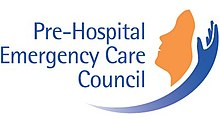PHECC
This article includes a list of references, related reading, or external links, but its sources remain unclear because it lacks inline citations. (August 2014) |
 | |
| Formation | 2000 |
|---|---|
| Legal status | Active |
| Headquarters | Naas, County Kildare, Ireland |
Region served | Ireland |
Director | Peter Dennehy |
| Website | http://www.phecc.ie |
| Remarks | Appointment: Minister for Health |
The Pre-Hospital Emergency Care Council (PHECC) is an independent statutory organisation responsible for implementing, monitoring and further developing the standards of care provided by all statutory, private and voluntary ambulance services in Ireland. It is also responsible for conducting examinations at six levels of pre-hospital care, the control of ambulance practitioner registration and the publication of clinical practice guidelines.
Levels of Care
There are six levels of care set down by PHECC. They are divided into Responder levels and Practitioner levels. Currently, all practitioners working on emergency ambulances must be trained to a minimum of PHECC Level 5 (Paramedic) standard. A practitioner working on a non-emergency ambulance must be trained to a minimum of PHECC Level 4 (EMT) standard. Responder levels are suitable for fire service personnel (excluding Dublin Fire Brigade), voluntary ambulance organisations, sports clubs and workplace first aiders.
Responders

Responder levels of care are designed to provide basic medical training to lay people, non-medical emergency services staff (Gardaí, fire services), sports club staff and those designated to provide first aid at work. In addition to this, voluntary ambulance services such as Civil Defence, Order of Malta Ambulance Corps, Irish Red Cross and the St John Ambulance Brigade of Ireland depend on responder training to allow their members provide on-site first aid at the various events they cover. Certain remote communities have set up their own individual Cardiac First Response programmes, where various people in the area are trained to PHECC Level 1 (CFR) standard and are provided with an Automated External Defibrillator. These responders can then be called or paged to the scene of a cardiac arrest to provide CPR and defibrillation, where the increased response time of an ambulance would greatly affect the patient's outcome.
Practitioners
Practitioners must register annually with PHECC to practice their skills. They are bound by various laws, primarily tort law when attending an incident or treating a patient. Upon qualification and registration, a practitioner is issued with a licence and unique PIN which should be presented when treating a patient either on or off-duty. The practitioner's PIN must also be entered on Patient Care Report forms for any incident where the practitioner was involved; this is done for both reference purposes, record-keeping and proof of continuous professional development.
| PHECC Responder Levels | ||
| Responder Title | Abbr | Level of Care |
| CARDIAC FIRST RESPONDER | CFR | Trained in BLS with emphasis on CPR and the Automated External Defibrillator |
| FIRST AID RESPONDER | FAR | Trained as CFR with additional training in management of bleeding, fractures etc. particularly in the workplace |
| EMERGENCY FIRST RESPONDER | EFR | Extensive first aid and BLS training with introduction to Oxygen therapy and assisting practitioners with care |
| PHECC Practitioner Levels | ||
| Practitioner Title | Abbr | Level of Care |
| Emergency Medical Technician | EMT | Entry-level qualification. Trained in BLS, Anatomy, Pharmacology, ECG Monitoring and Spinal Immobilization |
| Paramedic | P | Emergency Ambulance Practitioner. Airway management . IM & intranasal medications, 12 Lead ECG, manual defib etc. |
| Advanced paramedic | AP | Trained to Paramedic level plus IV & IO access, a wide range of Medications, tracheal intubation, Manual Defib etc. |
CPG Approved Service Providers
All organisations and companies who are providing an ambulance service in any capacity must register with PHECC as a CPG Approved Service Provider to work to the current edition of Clinical Practice Guidelines published by PHECC. Approved Service Providers are broken down into four categories. 2nd Edition CPG Providers are the Irish Defence Forces and Event Medical Services Ltd. 3rd Edition CPG Providers are listed below.
| Statutory | Auxiliary | Voluntary | Private |
|---|---|---|---|
| Dublin Fire Brigade | Civil Defence Ireland | Irish Red Cross | Beaumont Private Ambulance |
| HSE National Ambulance Service | CHC Ireland (Coast Guard Helicopters) | Order of Malta Ambulance Corps | Needford Ltd |
| Motorsport Rescue | St John Ambulance Brigade of Ireland | Murray Ambulance Ltd | |
| Dublin Airport Authority | Heart ER Ambulance | ||
| Lifeline Ambulance | |||
| Medicall Ambulance | |||
| Medicore Medical Services | |||
| Medilink Ambulance | |||
| Star of Life Ambulance | |||
| Cara Ambulance | |||
| Code Blue |
Citizen CPR campaign
In 2010, PHECC launched a poster-advertising and television-ad campaign aimed at informing the general public of what to do if they should witness an adult suddenly collapse. Its focus was to emphasise the fact that CPR can still be effective without mouth-to-mouth contact. Pocket-sized cards were distributed with instructions on the steps to take:
- Check: check if the person is unresponsive and not breathing.
- Call: Get someone to call 999 or 112 or call them yourself.
- Compress: Push hard and fast in the centre of the chest. Don't stop until help arrives.
See also
- Health Service Executive
- HSE National Ambulance Service
- Dublin Fire Brigade
- Civil Defence Ireland
- Order of Malta Ambulance Corps
- The St. John Ambulance Brigade of Ireland
- Irish Red Cross
